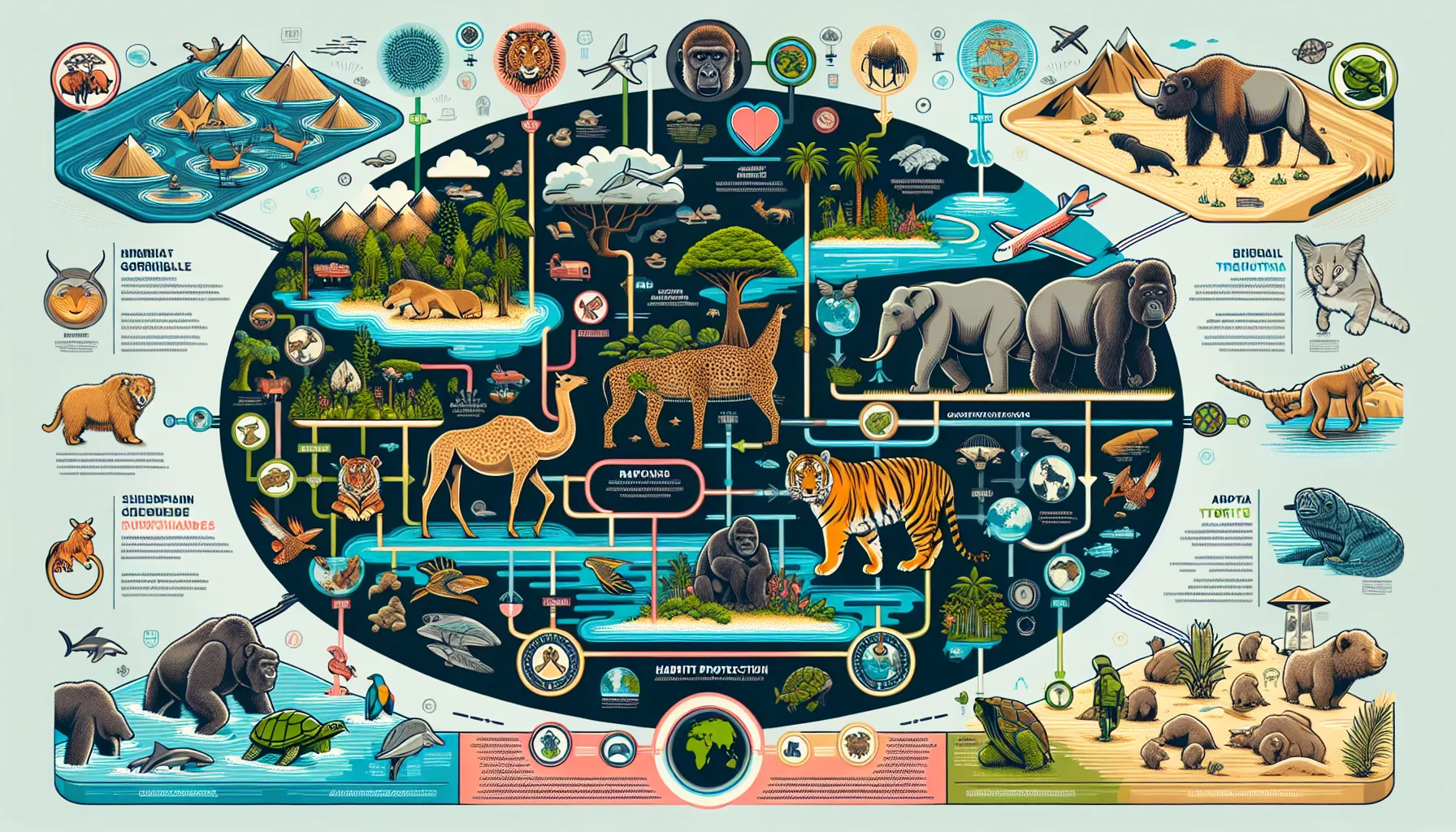The topic of conservation efforts to protect endangered species is a recurring theme in IELTS Writing Task 2. Based on analysis of past exams and current environmental issues, it’s highly likely that this subject will continue to appear in future tests. Let’s explore a relevant question that has been featured in recent IELTS exams:
Nội dung bài viết
Some people believe that it is more important to protect animals that are in danger of extinction than to protect the natural habitats of animals. To what extent do you agree or disagree?
Analyzing the Question
This question requires candidates to consider the relative importance of two conservation approaches: protecting endangered species directly versus preserving their natural habitats. Key points to address include:
- The relationship between species and their habitats
- The effectiveness of each approach in long-term conservation
- The potential consequences of focusing on one approach over the other
- Your personal stance on the issue
Sample Essays
Band 8-9 Essay
In the realm of wildlife conservation, the debate between prioritizing endangered species protection and habitat preservation is complex and multifaceted. While both approaches are crucial for maintaining biodiversity, I firmly believe that protecting natural habitats is ultimately more important and effective in ensuring the long-term survival of all species, including those at risk of extinction.
Firstly, natural habitats are the foundation of entire ecosystems, supporting not just endangered species but countless other plants and animals as well. By preserving these environments, we safeguard the delicate balance of nature that has evolved over millennia. For instance, the Amazon rainforest is home to numerous endangered species such as the jaguar and the golden lion tamarin, but it also plays a vital role in global climate regulation and supports countless other life forms. Protecting this habitat benefits not only the endangered species within it but also contributes to the overall health of our planet.
Moreover, focusing solely on endangered species without addressing habitat loss is akin to treating symptoms rather than the underlying cause. Many species become endangered precisely because their habitats are being destroyed or degraded. The critically endangered Sumatran orangutan, for example, is losing its home due to deforestation for palm oil plantations. Without preserving and restoring their natural forest habitat, any efforts to protect these primates directly will ultimately prove futile.
That being said, I acknowledge that there are situations where direct intervention to protect endangered species is necessary. In cases where a species is on the brink of extinction, targeted conservation efforts such as breeding programs or relocation initiatives can be crucial stopgap measures. The successful recovery of the California condor through captive breeding is a prime example of how such focused efforts can prevent imminent extinction.
However, these interventions should be viewed as temporary solutions while broader habitat conservation measures are implemented. The ultimate goal should be to create conditions where endangered species can thrive in their natural environments without constant human intervention.
In conclusion, while both approaches have their merits, I strongly believe that prioritizing habitat protection is the more comprehensive and sustainable strategy for wildlife conservation. By preserving natural ecosystems, we not only protect endangered species but also maintain the intricate web of life that supports all biodiversity on Earth. This holistic approach is essential for the long-term survival of endangered species and the health of our planet as a whole.
(Word count: 377)
 Endangered Species Conservation
Endangered Species Conservation
Band 6-7 Essay
The debate about whether to focus on protecting endangered animals or their natural habitats is an important one in conservation. While both approaches are valuable, I believe that protecting natural habitats is generally more important, although there are situations where direct species protection is necessary.
One main reason why habitat protection is crucial is that it helps many species at once, not just endangered ones. For example, protecting a rainforest area doesn’t just help rare animals like tigers, but also all the other plants and animals that live there. This approach is more efficient and has a bigger impact on maintaining biodiversity.
Another point is that many animals become endangered because their habitats are being destroyed. If we don’t protect these habitats, trying to save the endangered species alone won’t work in the long run. The pandas in China are a good example of this. Even though a lot of effort has gone into breeding pandas in captivity, they still need bamboo forests to survive in the wild.
However, I also think that there are times when focusing directly on endangered species is important. When an animal is very close to extinction, it might need special care and protection to survive. The kakapo, a rare parrot from New Zealand, has benefited from intensive conservation efforts that have helped increase its population.
In conclusion, while both approaches have their place, I believe that habitat protection should generally be the priority. It’s a more comprehensive way to protect not just endangered species, but entire ecosystems. However, in some cases, direct intervention to protect specific endangered species is also necessary.
(Word count: 269)
Band 5-6 Essay
I think protecting animals that are in danger of dying out is important, but protecting their homes is more important. Here’s why I think this:
First, when we protect an animal’s home, we help many animals, not just one. For example, if we save a forest, we help all the animals living there, not just the endangered ones. This is good because it helps more animals at the same time.
Also, many animals are in danger because their homes are being destroyed. If we don’t save their homes, trying to save the animals won’t work for long. Like with polar bears, if we don’t stop the ice from melting, they won’t have anywhere to live even if we try to protect them.
But sometimes, we need to help endangered animals directly. If there are only a few left, they might need special help to survive. The giant panda is an example of this. People have worked hard to help pandas have babies and survive.
In conclusion, I think saving animal homes is more important most of the time. It helps more animals and solves the bigger problem. But sometimes, we also need to help endangered animals directly if they are in big trouble.
(Word count: 196)
Explanation of Band Scores
Band 8-9 Essay
This essay demonstrates excellent language use, coherent argumentation, and a sophisticated approach to the topic:
- Task Achievement: The essay fully addresses all parts of the task, presenting a clear position with well-developed ideas and relevant examples.
- Coherence and Cohesion: Ideas are logically organized with clear progression throughout the essay. Paragraphs are well-linked, and cohesive devices are used effectively.
- Lexical Resource: A wide range of vocabulary is used accurately and appropriately, with good use of less common lexical items.
- Grammatical Range and Accuracy: A wide range of structures is used with flexibility and accuracy. Errors are rare and minor.
Band 6-7 Essay
This essay shows good language control and addresses the task well, but lacks some of the sophistication of the higher band essay:
- Task Achievement: The essay addresses all parts of the task, although some aspects are developed more fully than others.
- Coherence and Cohesion: There is a clear overall progression, but some paragraphs may be better connected.
- Lexical Resource: A sufficient range of vocabulary is used, with some less common items, though there may be occasional inaccuracies in word choice or collocation.
- Grammatical Range and Accuracy: A mix of simple and complex sentence forms is used, with good control overall, though there may be a few errors.
Band 5-6 Essay
This essay addresses the task in a basic way and uses simpler language:
- Task Achievement: The essay addresses the task, but the development of ideas is limited.
- Coherence and Cohesion: There is a basic organizational structure, but links between ideas may be unclear or repetitive.
- Lexical Resource: A limited range of vocabulary is used, adequate for the task but lacking precision.
- Grammatical Range and Accuracy: A mix of simple and complex structures is attempted, but errors are frequent, particularly in more complex sentences.
Key Vocabulary to Remember
-
Biodiversity (noun) /ˌbaɪəʊdaɪˈvɜːsəti/: The variety of plant and animal life in the world or in a particular habitat.
-
Ecosystem (noun) /ˈiːkəʊˌsɪstəm/: A biological community of interacting organisms and their physical environment.
-
Habitat (noun) /ˈhæbɪtæt/: The natural home or environment of an animal, plant, or other organism.
-
Conservation (noun) /ˌkɒnsəˈveɪʃn/: The protection of plants and animals, natural areas, and interesting and important structures and buildings, especially from the damaging effects of human activity.
-
Endangered (adjective) /ɪnˈdeɪndʒəd/: (Of a species) seriously at risk of extinction.
-
Extinction (noun) /ɪkˈstɪŋkʃn/: The state or process of a species, family, or larger group being or becoming extinct.
-
Preservation (noun) /ˌprezəˈveɪʃn/: The act of maintaining something in its original or existing state.
-
Biodegradation (noun) /ˌbaɪəʊˌdegrəˈdeɪʃn/: The decomposition of organic material by microorganisms.
-
Deforestation (noun) /diːˌfɒrɪˈsteɪʃn/: The action of clearing a wide area of trees.
-
Sustainability (noun) /səˌsteɪnəˈbɪləti/: The ability to maintain at a certain rate or level, especially regarding ecological balance.
Conclusion
Understanding the importance of conservation efforts to protect endangered species is crucial for success in IELTS Writing Task 2. The sample essays provided demonstrate different levels of language proficiency and approaches to addressing this topic. To improve your skills, practice writing essays on similar topics, such as:
- The role of zoos in conservation efforts
- The impact of climate change on endangered species
- The effectiveness of international agreements in protecting biodiversity
Remember to structure your essays clearly, use a range of vocabulary and grammatical structures, and provide specific examples to support your arguments. Feel free to share your practice essays in the comments section below for feedback and discussion. This active engagement will help you refine your writing skills and prepare effectively for the IELTS exam.
For more insights on related topics, you might find these articles helpful:


